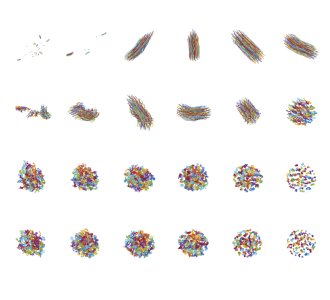Researchers from Oxford Mathematics and Imperial College London have provided a “'mathematical thought experiment' to inspire caution in biologists measuring heterogeneity in cell populations.
As technologies for gene sequencing and microscopy improve, biologists and biomedical researchers are increasingly able to distinguish heterogeneity in cell populations. And some of these differences in cellular behaviours can have important implications for biological functions, such as stem cells in embryonic development, or invasive malignant cells in the onset of cancer. But where will this trend of looking for heterogeneity lead? With a good enough microscope, every cell may look different. But is this meaningful?
To illustrate their point, Linus Schumacher and Oxford Mathematicians Ruth Baker and Philip Maini focused on an example of heterogeneity in migrating cell populations. They used statistics relating to delays in the correlation between individual cells' movements to examine whether it is possible to infer heterogeneities in cell behaviours. This idea originally stems from analysing the movements of birds, but has since been applied to cells too. By measuring when the movement of two cells (or birds) is most aligned, we learn if cells (or birds) move and turn simultaneously (no delay in correlations), or follow each other (delays in correlations). This is of importance to biologists interested in understanding if a subset of cells is leading metastatic invasion, for example, or the migration of cells in the developing embryo.
Using a minimal mathematical model for cell migration, Schumacher, Baker and Maini show that correlations in movement patterns are not necessarily a good indicator of heterogeneity: even a population of identical cells can appear heterogeneous, due to chance correlations and limited sample sizes. What’s more, when the authors explicitly included heterogeneity in their model to describe experimentally measured data, the model of a homogeneous cell population could describe the data just as well (albeit for different parameter values), heavily limiting what can be concluded from such measurements.
Thus, we have learnt that heterogeneity can naively be inferred from cell tracking data, but it may not be so meaningful. And the implications reach further than a particular type of data and specific statistical analysis. In an associated commentary, Paul Macklin of Indiana University illustrates a corollary of the main work: cell populations that divide with a fixed rate, or a distribution of division rates, can have the same distribution of cell cycle times (which could be measured experimentally). In this case, heterogeneity (whether it is real or not) is unimportant in understanding the observed biological phenomenon.
Lead author Linus Schumacher got the idea for this study while finishing his DPhil at the Wolfson Centre for Mathematical Biology in Oxford, and was enabled to continue working on it through an EPSRC Doctoral Prize award. The research appears on the cover of the August issue of Cell Systems.


